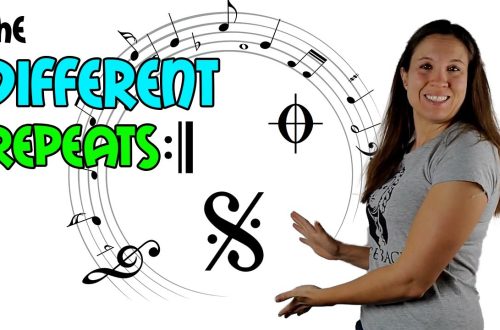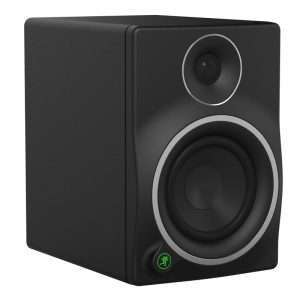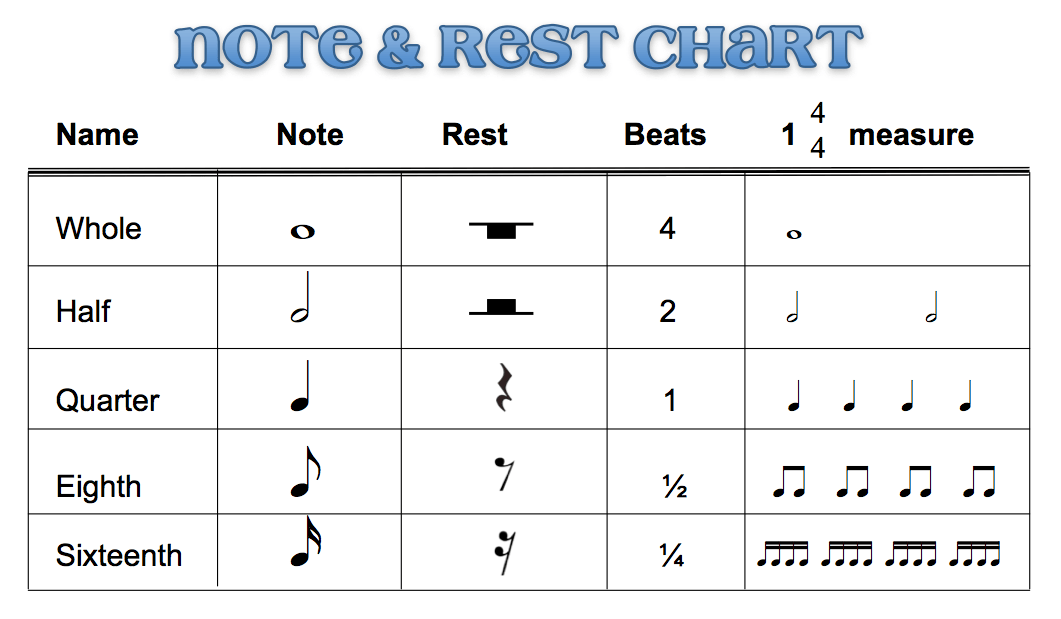
Signs that increase the duration of notes and rests
In earlier installments, we covered basic note and rest lengths. But there is such a variety of rhythms in music that sometimes these basic means of transmission are not enough. Today we will analyze several methods that help to record sounds and pauses of non-standard size.
To begin with, let’s repeat all the main durations: there are whole notes and pauses, half, quarter, eighth, sixteenth and others, smaller. The picture below shows how they look.
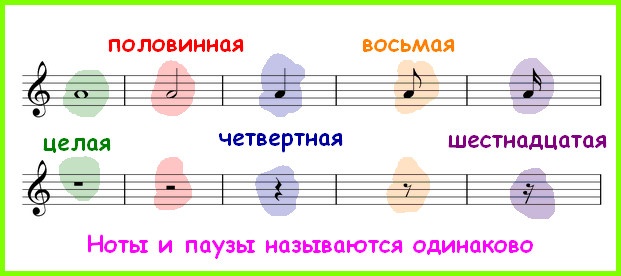
Further, for our convenience, let’s also agree on the conventions for durations in seconds. You already know that the actual duration of a note or rest is always a relative value, not constant. It depends on the pace at which the pulse beats in the piece of music. But purely for educational purposes, we still suggest that you agree that a quarter note is 1 second, a half note is 2 seconds, a whole note is 4 seconds, and what is less than a quarter – eighths and sixteenths will, respectively, be presented to us as a half (0,5 .1) and 4/0,25 of a second (XNUMX).
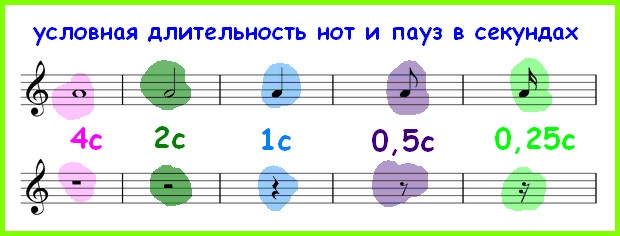
How can dots increase the duration of a note?
POINT – a dot that stands next to the note, on the right side increases the duration by exactly half, that is, one and a half times.
Let’s turn to examples. A quarter note with a dot is the sum of the time of the quarter itself and another note that is two times shorter than the quarter, that is, the eighth. And what happens? If we have a quarter, as we agreed, lasts 1 second, and the eighth lasts half a second, then a quarter with a dot: 1 s + 0,5 s = 1,5 s – one and a half seconds. It is easy to calculate that a half with a dot is the half itself plus a quarter duration (“half of the half”): 2 s + 1 s = 3 s. Feel free to experiment with the rest of the lengths.

As you can see, the increase in duration is real here, therefore the dot is a very effective and very important means and sign.
TWO POINTS – if we see not one, but two whole points next to the note, then their action will be the following. One point lengthens by half, and the second point – by another quarter (“half a half”). Total: a note with two dots increases in duration by 75% at once, that is, by three quarters.
Example. Whole note with two dots: the whole note itself (4 s), one dot to it represents the addition of a half (2 s) and the second dot indicates the addition of a quarter duration (1 s). In total, it turned out 7 seconds of sound, that is, as many as 7 quarters in this duration fit. Or another example: the half, too, with two dots: the half itself plus the quarter, plus the eighth (2 + 1 + 0,5) together last 3,5 seconds, that is, almost like a whole note.
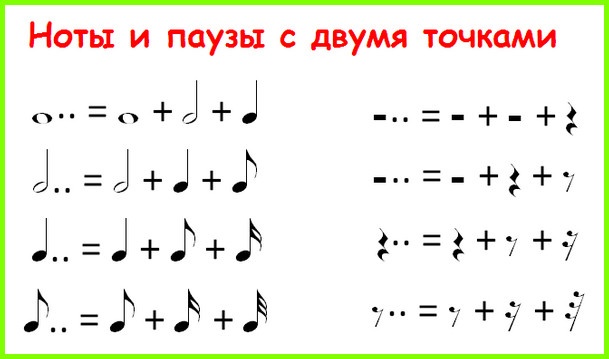
Of course, it is logical to assume that three and four points can be used on equal terms in music. This is true, the proportions of each new added part will be maintained in geometric progression (half as much as in the previous part). But in practice, triple dots are almost impossible to meet, so if you want, you can practice with their mathematics, but you don’t have to bother with them.
What is Fermata?
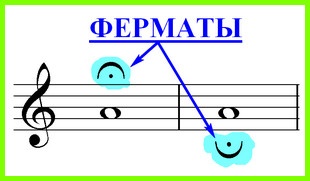 FERMATA – this is a special sign that is placed above or below the note (you can also over the pause). It is an arc curved into a semicircle (the ends look down like a horseshoe), inside this semicircle there is a bold point.
FERMATA – this is a special sign that is placed above or below the note (you can also over the pause). It is an arc curved into a semicircle (the ends look down like a horseshoe), inside this semicircle there is a bold point.
The meaning of the fermata can vary. There are two options:
- In classical music, fermata increases the duration of a note or pause by exactly half, that is, its action will be equivalent to the action of a point.
- In romantic and contemporary music, fermata means a free, non-timed delay in duration. Each performer, having met a fermata, must decide for himself how much to prolong the note or pause, how long to maintain. Of course, much in this case depends on the nature of the music and how the musician feels it.
Perhaps, after reading, you are tormented by the question: why do we need a fermata, if there is a point and what is the difference between them? The point is that dots always spend the main time in a measure (that is, they take the time that we calculate on ONE-AND, TWO-AND, etc.), but fermats do not. Fermatas are always aged with additional, “bonus time”. Therefore, for example, in a four beat measure (counting pulses up to four), a fermata on a whole note will be counted up to six: 1i, 2i, 3i, 4i, 5i, 6i.
Plus League
LEAGUE – in music, this is an arc connecting notes. And if two notes of the same height are connected by a league, which, moreover, stand one after the other in a row, then in this case the second note is no longer struck, but simply joins the first in a “seamless” way. In other words, the league, as it were, replaces the plus sign, she just attaches and that’s it.
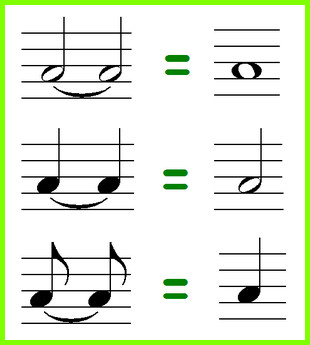 I foresee your questions of this kind: why are leagues needed if you can just write an enlarged duration at once? For example, two quarters are connected by a league, why not write one half note instead?
I foresee your questions of this kind: why are leagues needed if you can just write an enlarged duration at once? For example, two quarters are connected by a league, why not write one half note instead?
I answer. The league is used in cases where it is impossible to write a “general” note. When does it happen? Let’s say that a long note appears at the border of two measures, and it does not fit entirely into the first measure. What to do? In such cases, the note is simply split (divided into two parts): one part remains in one measure, and the second part, the continuation of the note, is placed at the beginning of the next measure. And then what was divided is sewn together with the help of a league, and then the rhythmic pattern is not disturbed. So sometimes you can’t do without a league.

Liga is the last of those note lengthening tools that we wanted to tell you about today. By the way, if dots and fermatas are used with both notes and reststhen only note durations are connected by a league. Pauses are not connected by leagues, but simply, if necessary, follow one after another in a row or are immediately enlarged into one more “fat” pause.
Let’s summarize. So, we looked at four signs that increase the duration of notes. These are dots, double dots, farms and leagues. Let’s summarize information about their action in a general table:
| SIGN | EFFECT OF THE SIGN |
| POINT | lengthens a note or rest by half |
| TWO POINTS | increase duration by 75% |
| FERMATA | arbitrary increase in duration |
| LEAGUE | connects durations, replaces the plus sign |
In future issues we will continue to talk about musical rhythm, learn about triplets, quartoles and other unusual durations, and also thoroughly analyze the concepts of bar, meter and time signature. See you soon!
Dear friends, you can leave your questions in the comments to this article. If you liked the material presented, tell about it on social networks, the special buttons that you will see below will help you with this. Thank you for your attention!



